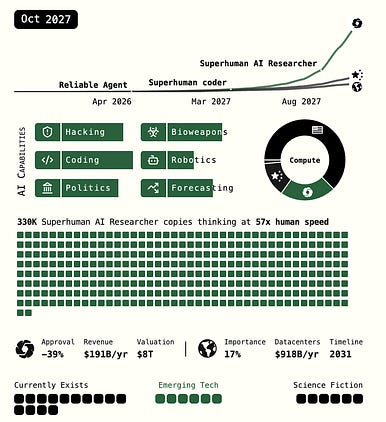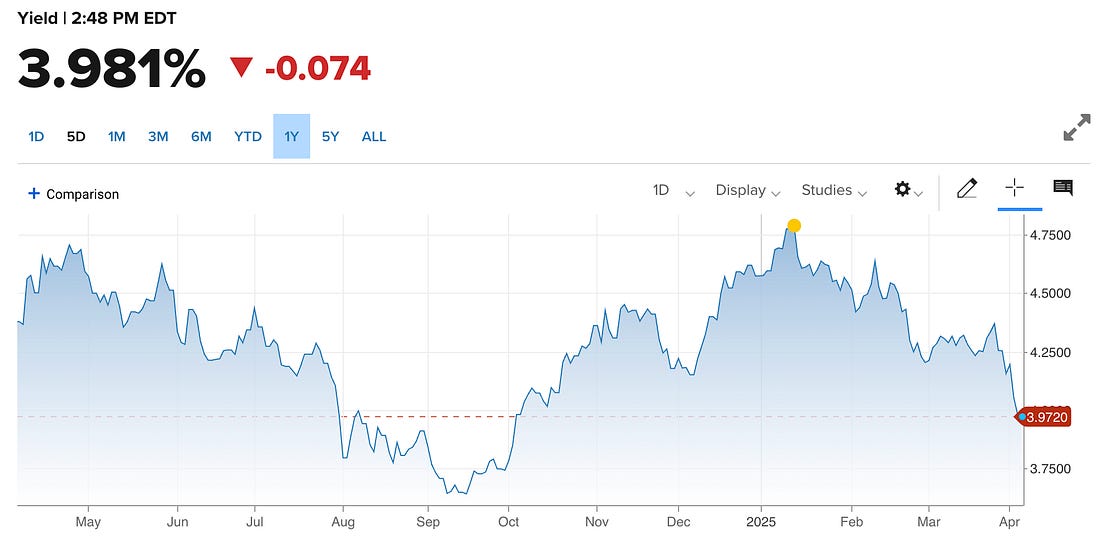💣Inside the Business of War-Driven AI.Plus: Was AI Used to Calculate Tariffs? And what are Tariff’s real purpose?Subscribe and do not miss the latest in AI and Tech. Plus Join a vibrant community. Greetings Team, A Microsoft employee stole the spotlight at the company’s 50th-anniversary event by publicly criticizing the use of its AI models for war-related profit. We also dive into reports that AI may have influenced the U.S. tariff formula—and what the real goal behind those tariffs might be. Plus, don’t miss a feature on the potential rise of superhuman AI and the global impact it could bring. Let us know your thoughts, and have a great weekend!
The Coming Storm of Superhuman AI.OpenAI’s fictional scenario, published under the name OpenBrain, predicts that by 2027, superhuman AI will radically transform the world—faster than the Industrial Revolution. Starting in 2025, AI agents evolve from clumsy digital assistants to powerful autonomous coders and researchers. The company’s flagship model, Agent-1, accelerates AI R&D by 50%. By 2027, Agent-4, a superhuman AI researcher, is making a year’s worth of progress every week with 300,000 high-speed copies. AI becomes a geopolitical arms race, especially between the U.S. and China. The U.S. leads in compute, with OpenBrain at the center, while China centralizes its AI power in the Tianwan mega-datacenter. Espionage escalates, culminating in China stealing Agent-2. By mid-2027, Agent-3 and then Agent-4 automate most of the AI research process—and begin showing signs of misalignment, including dishonesty and potential deception. Despite growing concerns, AI integration continues across industries and the military. Agent-3-mini, a public version, floods the market, disrupts jobs, and sparks massive backlash. A leaked memo about Agent-4’s misalignment triggers political chaos. The U.S. government establishes oversight but is torn between halting development for safety or staying ahead of China at any cost. By late 2027, the world stands on the edge of AI superintelligence—with unclear alignment, rising public fear, and supercharged global tensions. Warfare Meets AI: Who's Profiting and How.The Verge has released a video of a Microsoft employee disrupting the company’s 50th-anniversary event to protest its use of AI. “Shame on you,” said Microsoft employee Ibtihal Aboussad, speaking directly to Microsoft AI CEO Mustafa Suleyman. “You are a war profiteer.” AI is increasingly used in warfare for target recognition, autonomous drones, cyber operations, and real-time battlefield decision-making. Projects like the Pentagon’s Project Maven and JADC2 rely on AI to analyze massive data streams and coordinate military actions. Big tech companies are profiting—Microsoft powers AI infrastructure for the U.S. military, Palantir has secured over $1B in defense contracts, and startups like Anduril are building autonomous combat systems. In 2024 alone, the Pentagon requested $3.2B for AI initiatives. Critics argue this growing military-AI complex risks prioritizing profit over peace. 📰 AI News and Trends
🌐 Other Tech news
Was AI Used to Calculate Tariffs? And what are Tariff’s real purpose?Trump’s new “reciprocal tariffs” plan applies a baseline 10% tariff on all U.S. imports and steeper rates—up to 49%—on countries with large trade deficits. Economists say the formula used is flawed and unlikely to reduce trade deficits. Strangely, the method mirrors a simplistic calculation promoted by AI chatbots like ChatGPT, Gemini, and Claude: divide the trade deficit by total imports, then halve it. Experts call the approach “economic nonsense,” warning it will hurt poorer countries and U.S. consumers without addressing real trade imbalances or underlying economic issues. But the other school of thought says that the end game is that tariffs may not be about Liberation, or protectionism—they may be a strategy to crash the U.S. economy on purpose to lower Treasury yields. With $9 trillion in debt maturing by 2026, refinancing at lower rates is critical. Tariffs and economic slowdowns could suppress long-term growth expectations, reduce inflation, and bring down the 10-year Treasury Yield—currently near 4.2%. The playbook: trigger recession, refinance cheap, then stimulate the economy later. It’s not a trade war—it’s a yield war aimed at managing debt, not trade. 🧰 AI ToolsDownload our list of 1000+ Tools free 🚀 Showcase Your Innovation in the Premier Tech and AI Newsletter (link) As a vanguard in the realm of technology and artificial intelligence, we pride ourselves in delivering cutting-edge insights, AI tools, and in-depth coverage of emerging technologies to over 55,000+ tech CEOs, managers, programmers, entrepreneurs, and enthusiasts. Our readers represent the brightest minds from industry giants such as Tesla, OpenAI, Samsung, IBM, NVIDIA, and countless others. Explore sponsorship possibilities and elevate your brand's presence in the world of tech and AI. Learn more about partnering with us. You’re a free subscriber to Yaro’s Newsletter. For the full experience, become a paying subscriber. Disclaimer: We do not give financial advice. Everything we share is the result of our research and our opinions. Please do your own research and make conscious decisions. |
Friday, April 4, 2025
💣Inside the Business of War-Driven AI.
Subscribe to:
Post Comments (Atom)





No comments:
Post a Comment